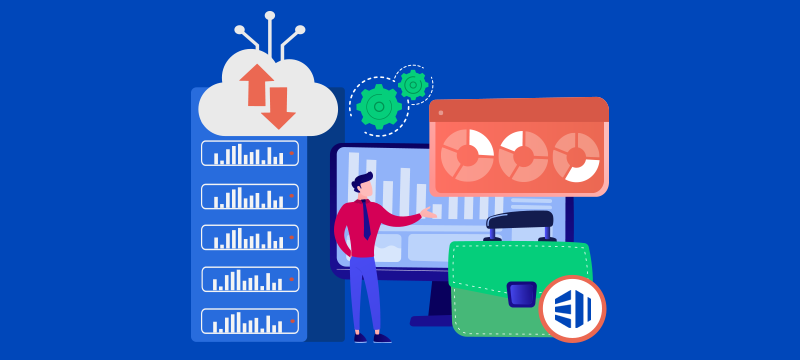One of the more recent technologies to be adopted by the web hosting industry, edge computing brings a wide range of benefits for online businesses. In this post, we look at what edge computing is and how it is helping companies operate their online services better.
Contents
What is edge computing?
The vast majority of online data that businesses use today is processed in large, centralised data centres. This means it has to travel from the device on which it has been created to the data centre, sometimes thousands of miles away, with any response having to travel back the same distance. Despite the blistering speeds of modern servers and networks, this still takes time, resulting in delays. With edge computing, data is processed close to where it is generated, i.e., at the edge of the network rather than in a data centre. This reduces the distance the data has to travel and thus speeds up processing and performance. Edge computing can use a range of different devices to carry out the processing, these include edge servers, smartphones, smart routers and IoT devices.
Carrying out processing closer to where it has been created brings many benefits for businesses and their customers. Here are some of the most advantageous.
Reduced latency
Centralised processing in data centres results in latency or delay. In most circumstances, the speed of modern networks is so fast that the delay doesn’t cause any major problems. We hardly notice it, if at all. Where it does become an issue is for websites and applications that require real-time responses or interactions. For example, as the prices of shares constantly fluctuate, a banker needs to know the precise value of a stock before buying or selling. A split-second delay in these circumstances could be very costly. It’s the same for online auctions, multiplayer gaming and similar activities. The advantage of edge computing here is that delays are reduced, and real-time data is more accurate.
Improved speed
Any reduction in delay also improves the speed of applications and websites. Website users can be impatient when it comes to slow page loading and response to interactions and will abandon websites that are too slow. At the same time, search engines reward fast-performing sites with higher rankings in their search results. Making use of edge servers, including content delivery networks and international dedicated servers, can make a significant difference, especially for businesses that have interactive, customer-facing applications, chatbots and video or audio content.
For more, readGlobal Impact of International Dedicated Servers on Website Load Times
More bandwidth
During peak times, businesses can often face bandwidth issues due to the demand on their servers and network, especially where there is limited scope for upward scaling. This can result in sluggish performance or if the demand is too high, a crash. By processing more of their data at the edge of a network, the demand on a company’s central servers can be alleviated. As a result, they will have more bandwidth during peak times, ensuring better performance and stability.
A new way to scale up
Traditionally, businesses scale up in the data centre. For example, they can add more cloud resources or scale horizontally or vertically with dedicated servers. While it is highly beneficial to be able to do this, scaling does come with cost implications. With edge computing, businesses can scale their operations using the capacity of their edge resources as well as those in the data centre. Aside from helping to keep costs down, this can also improve the speed at which scaling takes place, especially for those not using the cloud.
Increased reliability
In the same way that hosting providers ensure reliability by moving virtual servers from one physical machine to another in the event of hardware failure in a data centre, edge computing enables businesses to seamlessly move operations from one edge server to another, should there be an issue. As a result, companies can reduce the potential for downtime and thus have greater confidence in delivering uninterrupted service for their critical applications. Just like in data centres, it is also possible to monitor edge servers to identify potential issues so that problems can be fixed quickly and services moved before they impact users.
Compliance benefits
By processing data within the region where it was generated, edge computing can also be helpful for improving compliance with data protection regulations like GDPR. Some countries require data to be stored and processed locally while others require any data being moved across borders to meet specific requirements, such as the consent of the data citizen or there being adequate protections in place.
By processing data locally, many of the bureaucratic hurdles of moving data to other countries can be dispensed with while it is also easier to comply with local regulations.
Enhanced security
In addition to compliance, edge computing can also improve security, for example, local processing reduces the chance that data can be intercepted and stolen as it travels to a data centre. What’s more, as the data is stored across many devices rather than centrally, should there be a data breach, it is likely to have a smaller impact as not all of it will be accessible to attackers. Businesses can also implement custom security measures at the various edge locations to protect the specific types of data that are being processed there.
Cutting costs
With so much data being processed, the costs of transferring data to a data centre can be prohibitive. When data is processed at the edge, however, the volume of data needing to be sent to the data centre can be dramatically reduced, thus slashing data transfer costs. For businesses with in-house data centres, edge processing can also reduce the amount of power and cooling required onsite.
Looking for more ways to cut costs? Read: How to Achieve Cost Optimisation through Managed Cloud Services?
Intelligent content delivery
As it is possible to monitor network traffic and demand in real time, edge computing enables businesses to optimise how and where content is delivered. For example, if an edge server is located near a substantial number of users, it can be used as a local content delivery network, caching content during busy periods to speed up loading times.
Making use of IoT
From kettles and cars to smart towns and industrial machinery, the number of IoT devices being used today is expanding exponentially. However, they generate huge amounts of data that businesses need to process, often in real-time. Edge computing is an ideal solution for companies that deploy or sell IoT devices as it speeds up local processing, improves the accuracy of time-based data and helps cut the costs of data centre transfer, processing and storage.
For more read: What is IoT & How IoT is Transforming Modern Business
Conclusion
The availability of edge computing offers numerous ways for businesses to boost their web hosting performance. Aside from reduced latency and increased speed, it helps cut costs, improves security and compliance, and expands bandwidth. In addition, it enhances scalability, optimises content delivery and makes it easier to deploy IoT devices. As a result, it offers tangible benefits for businesses that need smarter solutions to manage their growing data.
For data centre infrastructure that works in harmony with edge computing, and is designed for mission-critical applications, take a look at our Cloud Hosting Solutions.



